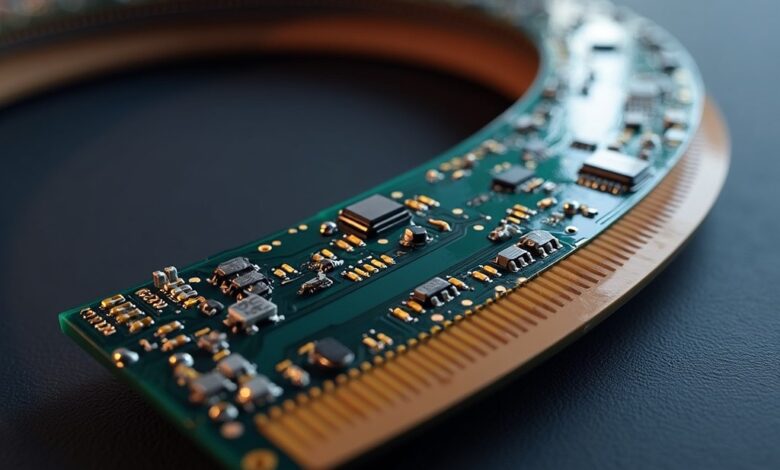Key Advantages of Using Flexible PCBs in Modern Electronics

Flexible Printed Circuit Boards (PCBs), such as OurPCB flexible PCB, have become a game-changer in the electronics industry. Their unique ability to bend, fold, and twist without affecting performance offers significant advantages over traditional rigid PCBs. As modern electronics continue to evolve, devices are becoming smaller, lighter, and more complex—making the versatility of flexible PCBs indispensable. In this article, we will explore the key advantages of using flexible PCBs in modern electronics.
1. Space-Saving Design
One of the most significant advantages of flexible PCBs is their ability to save space. In traditional PCBs, components are laid out on a rigid, flat surface. However, flexible PCBs can bend and fold, allowing designers to place components in tighter spaces and create more compact electronic devices.
This feature is particularly useful in industries such as consumer electronics, medical devices, and aerospace, where space constraints are critical. By using flexible PCBs, designers can create smaller, more portable devices without sacrificing functionality.
2. Reduced Weight
Along with saving space, flexible PCBs contribute to reducing the overall weight of electronic devices. Since they are made from lightweight materials such as polyimide or polyester film, flexible PCBs are significantly lighter than their rigid counterparts.
This weight reduction is especially important in applications like drones, wearables, and portable medical devices, where minimizing weight can improve performance, battery life, and user comfort.
3. Enhanced Durability and Reliability
Flexible PCBs are designed to withstand mechanical stress, making them more durable than rigid PCBs in environments that experience frequent movement or vibration. Their flexibility allows them to absorb shocks, bends, and twists without damaging the circuitry, ensuring the device continues to function effectively.
For example, in automotive and industrial applications, where devices are subjected to continuous motion, flexible PCBs can improve reliability by minimizing the risk of circuit breaks and mechanical failures.
4. Cost-Effective Assembly
Flexible PCBs can be more cost-effective than traditional rigid boards, especially when considering their ability to eliminate the need for complex wiring harnesses or connectors. Instead of multiple separate boards and cables, flexible PCBs can integrate various components into a single piece, simplifying the assembly process.
This reduction in parts not only lowers material costs but also decreases manufacturing time and labor expenses, making flexible PCBs a more economical choice for complex electronic devices.
5. Improved Heat Dissipation
Flexible PCBs can improve heat dissipation in electronics, an essential factor for devices that generate significant amounts of heat, such as power supplies and LED lighting systems. Their thin and flexible structure allows for better airflow, which helps dissipate heat more efficiently than rigid PCBs.
Additionally, flexible PCBs can be designed with thermal vias or specialized materials to enhance heat transfer, preventing overheating and ensuring the longevity of electronic components.
6. High-Density Interconnection
The compact nature of flexible PCBs allows for high-density interconnection, enabling designers to fit more components into a smaller area. This is particularly beneficial for complex devices that require numerous connections, such as smartphones, cameras, and wearables.
By optimizing space and connection density, flexible PCBs can enhance the performance and functionality of modern electronics without increasing their size or weight.
7. Increased Design Flexibility
The ability of flexible PCBs to bend, fold, and conform to various shapes gives engineers greater design flexibility. Unlike rigid PCBs that must fit within specific dimensions, flexible PCBs can be designed to fit irregularly shaped spaces, providing more creative freedom in the overall design of a device.
This feature is especially valuable in applications where space is limited, or the design requires unconventional shapes, such as in medical devices, aerospace components, or custom electronics.
8. Fewer Interconnections and Simplified Assembly
Traditional electronic devices often require multiple circuit boards connected by cables or connectors, increasing the number of interconnections. Each interconnection represents a potential point of failure, which can compromise the reliability of the device. Flexible PCBs can integrate multiple circuits and components into a single, unified board, reducing the need for interconnections.
- Reduced failure points: Fewer interconnections mean fewer potential failure points, enhancing the overall reliability of the device.
- Simplified assembly: The reduction in components and connectors simplifies the assembly process, reducing labor costs and production time.
9. Versatility in Applications
Flexible PCBs are incredibly versatile and can be used across a wide range of industries and applications. Whether in compact consumer electronics or critical medical equipment, flexible PCBs can be adapted to meet the specific needs of the device.
Some common applications of flexible PCBs include:
- Wearable technology: Fitness trackers, smartwatches, and medical wearables benefit from the lightweight and flexible nature of flexible PCBs.
- Automotive industry: Flexible PCBs are used in control systems, sensors, and lighting within vehicles, thanks to their durability and ability to withstand vibration.
- Aerospace and defense: The ability of flexible PCBs to perform reliably in harsh environments makes them suitable for aerospace and military applications.
10. Better Electrical Performance
Flexible PCBs can provide better electrical performance than traditional rigid boards due to their reduced need for interconnections and the proximity of components. With fewer connectors and joints, flexible PCBs have shorter signal paths, which helps reduce electrical noise and signal loss.
For high-frequency applications or devices that require high-speed data transmission, such as smartphones or telecommunications equipment, flexible PCBs offer enhanced signal integrity, contributing to faster, more reliable performance.
11. Adaptability to Harsh Environments
Flexible PCBs are well-suited for use in harsh or challenging environments. Their flexible design allows them to perform well in extreme conditions, such as high temperatures, humidity, or environments where mechanical stress is present.
Many flexible PCBs are made from materials that are resistant to heat, chemicals, and moisture, making them ideal for use in outdoor or industrial settings where durability and reliability are critical.
Conclusion
The advantages of using flexible PCBs in modern electronics are numerous. From space-saving designs and lightweight construction to improved durability and heat dissipation, flexible PCBs provide a range of benefits that make them essential in today’s increasingly complex electronic devices. Their ability to enhance performance, reduce costs, and adapt to various applications ensures that flexible PCBs will continue to play a crucial role in the future of electronic design.
By choosing flexible PCBs, manufacturers can create smaller, more efficient devices that meet the growing demand for high-performance electronics in a wide array of industries.



